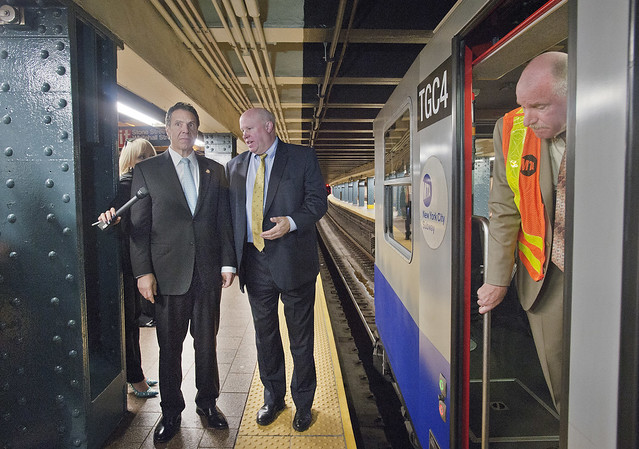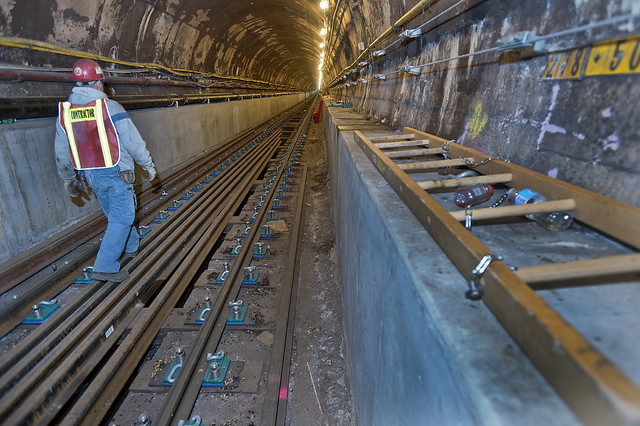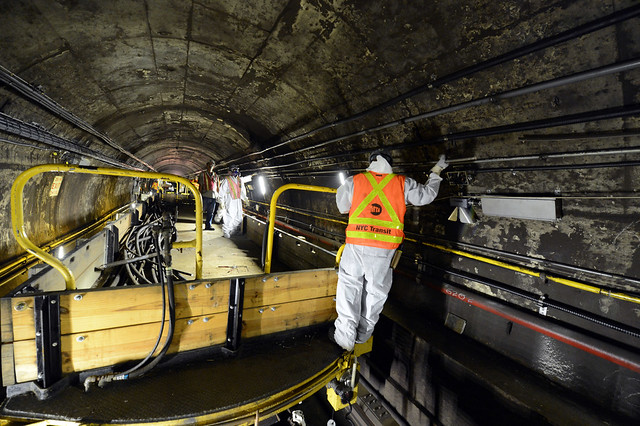The L train riders have a problem. Due to the millions of gallons of saltwater that flooded the Canarsie Tubes during Hurricane Sandy, a prolonged shutdown of the L train’s connection to Manhattan is all but inevitable. This work isn’t expected to start until mid-2017, and the agency is struggling to determine if a three-year shutdown that may allow single-tracking is preferable to a 14-18 month total shutdown of service. From local businesses to housing to daily commuters, the L train shutdown is a Problem with a capital P.
Even as plans are up in the air, Northern Brooklyn residents aren’t happen. Therein lies the MTA’s problem. Based on a general distrust of an agency that has failed to deliver projects on time and on budget and has a reputation, deserved or otherwise, for a lack of transparency (we always knew that lingering trope about two sets of books would come back to bite), New Yorkers simply do not trust the MTA. So when the MTA says it has to shutdown the L train for a prolonged period of time but doesn’t sufficiently explain the depths of the work or the extent of the damage, the public who would have to suffer through longer trips on crowded trains will be skeptical and angry.
Yesterday, that anger unfolded in an entirely unproductive and childish way that benefits no one involved in this process. What was supposed to be a private meeting during which community leaders were to voice their concerns turned into a public forum for politicians to grandstand and business owners to vent. To more or less ended when community leaders kicked out the MTA representative they had invited to attend the meeting to hear their concerns. It’s my understanding that, when the MTA accepted the invite, they did so telling the community that plans were not ready for public discussion. The community members acknowledged this limitation but then were critical when the MTA failed to disclose plans the agency didn’t have. It was, in essence, a public ambush that ended with an eviction. It’s made for a nice bit of theater but has led to more distrust on both sides of a process that needs to be collaborative and cooperative.
Let’s see how this unfolded via Twitter coverage:
Member of public on potential #Ltrain tunnel closure: "until we know there are no other options we shouldn’t even entertain that option."
— Kate Hinds (@katehinds) January 28, 2016
Real estate broker: "There's already been a lot of damage based on the speculative nature of not knowing how it’s going to be done." #Ltrain
— Kate Hinds (@katehinds) January 28, 2016
Retail broker says deals are already falling thru bc ppl can't make decisions. "Concrete information will help" #Ltrain
— Serena Dai (@ssdai) January 28, 2016
Do you have a timetable for us? @MTA: "Not at this time." Any timetable? "No." Can we see engineering report? "I'll ask." #Ltrain
— Kate Hinds (@katehinds) January 28, 2016
Felice Kirby kicked MTA rep out of meeting on L train shutdown- "We aren't getting information, aren't getting any solid answers."
— Danielle Furfaro (@DanielleFurfaro) January 28, 2016
Sen. Dilan says he will hold up MTA capital budget until the agency comes up with a decent plan for the L train.
— Danielle Furfaro (@DanielleFurfaro) January 28, 2016
That same state pol now claiming that L train tunnel damage is a conspiracy, was hidden from the public. Your elected officials, everyone!
— Jose Martinez (@JMartinezNYC) January 28, 2016
Consensus being formed at #Ltrain meeting around idea that community wants independent engineer to assess problems in Canarsie Tube.
— Kate Hinds (@katehinds) January 28, 2016
State officials say if MTA won't say publicly what they are considering re: Canarsie Tube, the MTA needs to explain how damaged tunnel is
— Becky Harsh (@rebeccaugust) January 28, 2016
Councilman Steve Levin says MTA has "casual attitude" on L train tunnel closure that is unacceptable.
— NYDN Transit (@NYDNTransit) January 28, 2016
@2AvSagas one resident/store owner told me she left the meeting worried about the safety of riding through the tube today
— Dan Rivoli (@danrivoli) January 29, 2016
Following the meeting, an MTA spokesman express the agency’s commitment to cooperation, saying: “The safety of riders must be the number one priority. The Canarsie tube suffered serious damage during superstorm Sandy, and it must be repaired. The MTA is looking for the best ways to mitigate the service disruptions and customer inconvenience that will result from this critical repair work. As we have made clear both prior to and at the meeting, we are committed to maintaining a dialog with the affected communities as we analyze the options. As the process moves forward we will continue to listen to ideas from our riders, local businesses and elected officials.”
From where I sit, the path forward is simple but will take some trust-building on both sides. The MTA has to be transparent with the state of the Canarsie Tube. If riders and residents fear for their safety, the MTA hasn’t done a good job explaining what work needs to be done and why or what the status of the tube currently is. While those aware of the extent of Sandy’s damage could point to the R train’s Montague St. Tube as a good example, the MTA can’t work from the assumption that casual L train riders know or care about work that happened on the R line. While you and I may pay attention to these things, for the vast majority of New Yorkers, the subway is the line they take on a daily basis, and L train riders through the Canarise Tube aren’t R train riders through the Montague St. Tube. Sandy was now over three years ago, and memory fades fast.
On the other hand, the community should be understand about expressing their concerns in a collaborative and cooperative process. If they’re not getting answers, the solution isn’t to expel the person listening to their concerns from the meeting. Rather, work together to find out a way forward. Furthermore, politicians like Sen. Martin Dilan shouldn’t threaten access to billions of dollars of badly-needed funding to fulfill a personal vendetta. That is a counterproductive step in a process fraught with complications.
So now a detente settles in until the next meeting in February. This work is still far off, but the path forward is opening up. We’ll see how the sides respond next time, but hopefully, transparency and maturity will rule that meeting. Otherwise, it’s going to be a long few years for L train riders.

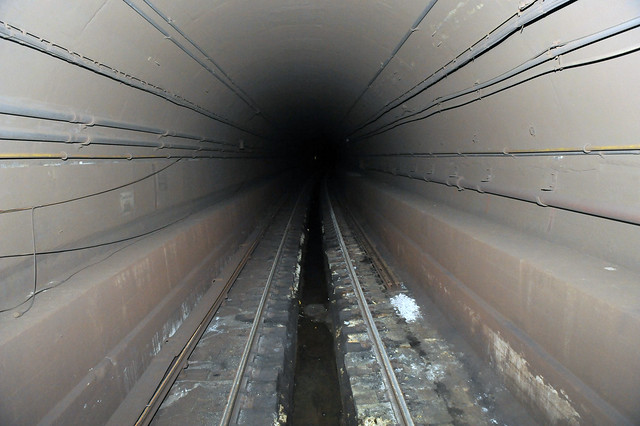
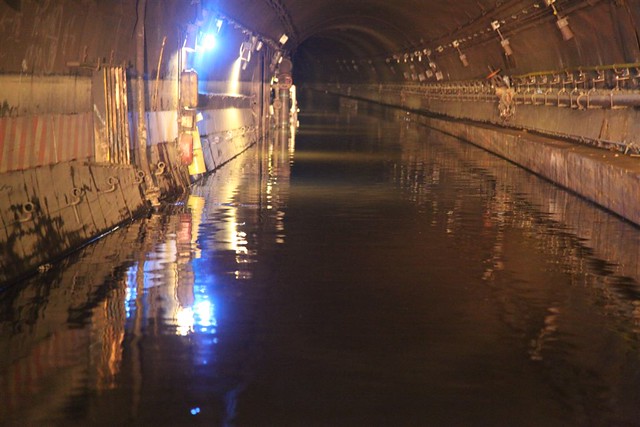

 For the MTA, it’s hard to find much good in the outcome from Superstorm Sandy. The saltwater that flooded the city’s subway tunnels significantly sped up an already-looming aging process, and the agency has had to spend federal dollars and manpower on restoration rather than, say, expansion. R and G train riders suffered through a lengthy service shutdown, and A and C train riders are in for a year of weekend service changes as the MTA rebuilds systems taken out by Sandy. But out of a crisis comes opportunity, and the L train is set to be the beneficiary of a bad situation.
For the MTA, it’s hard to find much good in the outcome from Superstorm Sandy. The saltwater that flooded the city’s subway tunnels significantly sped up an already-looming aging process, and the agency has had to spend federal dollars and manpower on restoration rather than, say, expansion. R and G train riders suffered through a lengthy service shutdown, and A and C train riders are in for a year of weekend service changes as the MTA rebuilds systems taken out by Sandy. But out of a crisis comes opportunity, and the L train is set to be the beneficiary of a bad situation. 
